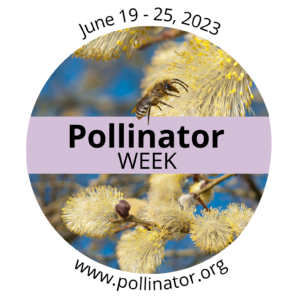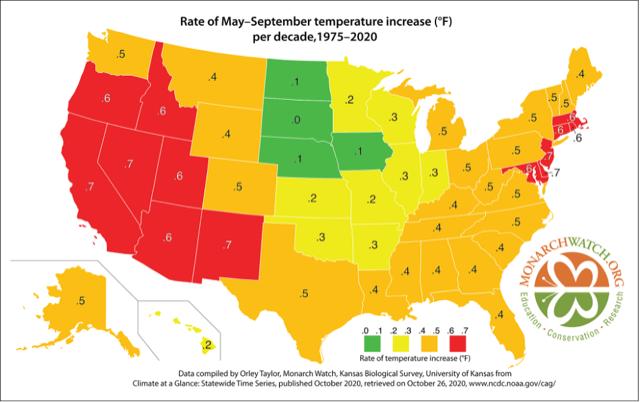 Today is the first day of Pollinator Week, an annual celebration in support of pollinator health that was initiated and is managed by Pollinator Partnership. The theme of this year’s Pollinator Week is emphasizing the connections between climate and pollinators. Few individuals are as closely tied to the weather patterns as farmers. Farmers track temperature, rainfall, drought, wind, forecasts, and climate because their living is directly affected by these atmospheric events. Farmers have also witnessed firsthand how a changing climate has skewed traditional planting, growing, and harvesting seasons, often personally experiencing detrimental threat of extreme weather on individual livelihood.
Today is the first day of Pollinator Week, an annual celebration in support of pollinator health that was initiated and is managed by Pollinator Partnership. The theme of this year’s Pollinator Week is emphasizing the connections between climate and pollinators. Few individuals are as closely tied to the weather patterns as farmers. Farmers track temperature, rainfall, drought, wind, forecasts, and climate because their living is directly affected by these atmospheric events. Farmers have also witnessed firsthand how a changing climate has skewed traditional planting, growing, and harvesting seasons, often personally experiencing detrimental threat of extreme weather on individual livelihood.
The vast majority of farmers recognize the impact of climate change. The 2020 Iowa Farm and Rural Life Poll survey explored farmers’ perspectives on climate change and ways that farmers can address its impacts on agriculture. The survey found that 81% of farmers indicated that climate change is occurring and over half reported that they are concerned about the potential impacts of climate change on their farm operations.

Both farmers and pollinators like the monarch coexist in a delicate lifecycle subject to the ebbs and flows of the environment. Just as a farmer’s livelihood is impacted by climate change, so is the life cycle of the monarch. Farmers for Monarchs has previously written how the monarch butterfly population has been impacted by climate change. It is not just about the types of forage and resources that monarchs need to survive but the timing of when those resources are available. The migratory generation of monarchs that departs for their overwintering grounds each fall relies on late season wildflowers to fuel their flight. As with farming, overwintering monarchs require “Goldilocks” type conditions – not too hot, not too cold – to survive the winter without freezing and without using too much of their energy reserve. In their final attempts to get the next generation off to a good start, the overwintering generation moves north and relies on abundant spring milkweed that is well-timed with their arrival in the southern U.S. As subsequent generations move north following their milkweed host plants, weather conditions in different geographies might delay them, or push them ahead too quickly. Summer breeding generations need abundant milkweed and nectar resources to help build a robust migratory generation come fall, and then the cycle begins again. With this multi-generational migration cycle, you can see how disrupting just one link in this chain can be detrimental to the success of subsequent generations, and thereby the entire population.
We’ve already seen examples of these disruptions in recent years. Last month we shared the encouraging news of a robust western monarch population that was counted at the end of 2022. Powerful winter storms in California, however, are threatening this year’s breeding cycle. Significant winter storms in Texas in recent years have also knocked back plant vegetation, bringing speculation about whether or not native milkweeds would have enough time to bounce back before the monarchs arrived. Luckily, they did in 2021, but the monarch may not be so lucky in the future. Severe drought conditions across the western landscape are also cause for concern. It is difficult to grow plants – crops or native plants – without water. And on the inverse, significant flooding in the Midwest in recent years have taken a toll on both agriculture production and forage for monarchs and pollinators.
The Iowa Farm and Rural Life poll also found that nearly 60% of farmers agreed that they should take steps to protect the land they farm from severe weather events like precipitation. Some of these steps farmers can take to protect their land can also be beneficial for monarchs, such as developing widespread habitat that include diverse plant species. More habitat simply makes it easier for monarchs to find suitable plants on which to lay eggs or find nectar or a mate. Additionally, pollinator plantings on non-crop lands protect against erosion and can act as a carbon sink.
Farmers for Monarchs stands ready to assist farmers meet their conservation goals. Simply contact the Pollinator Habitat Help Desk at (337) 422-4828 or (337) HABITAT for more information on planting milkweed and other pollinator habitat on your land, or participating in cost-sharing programs like the Conservation Reserve Program.
